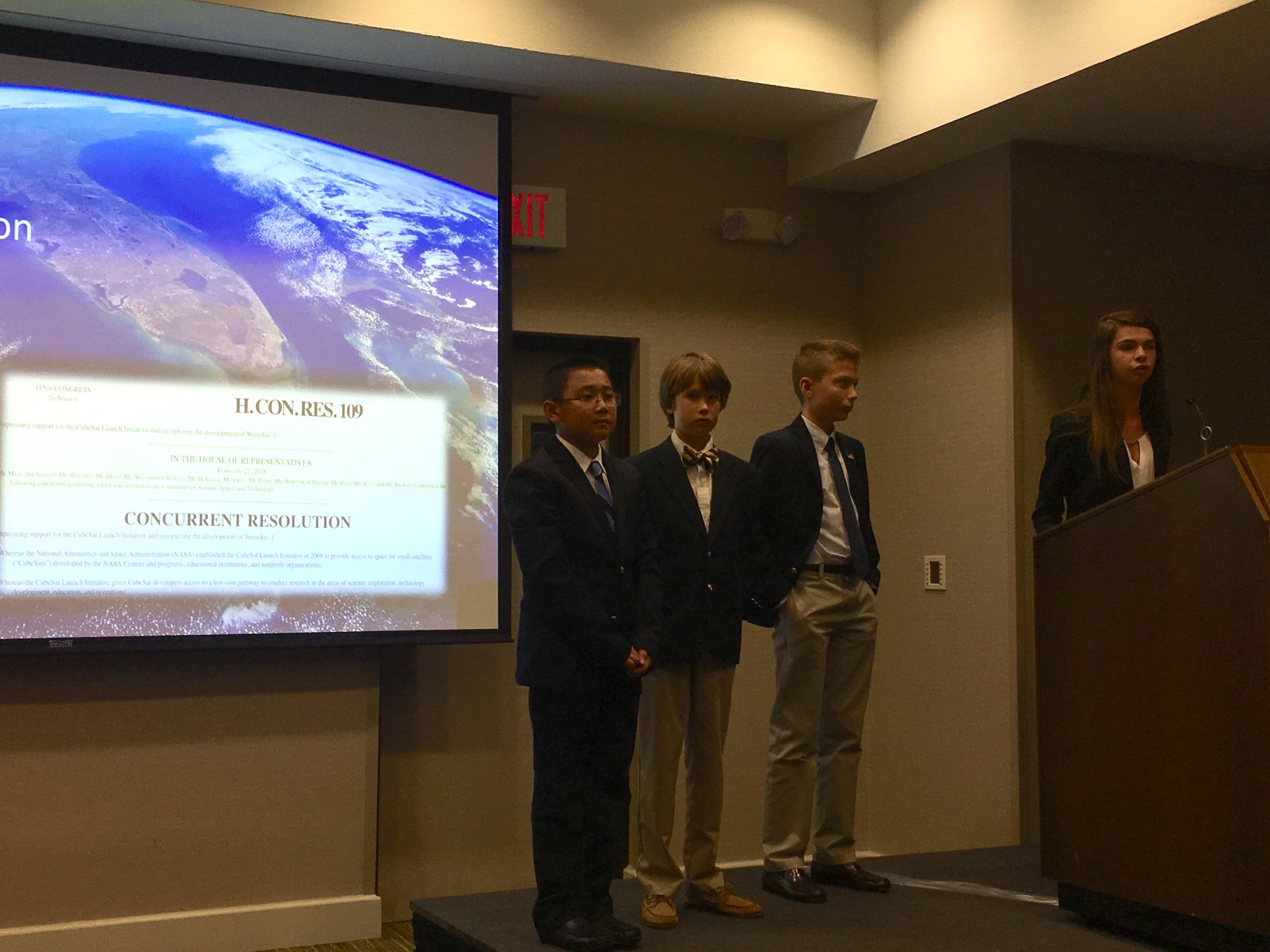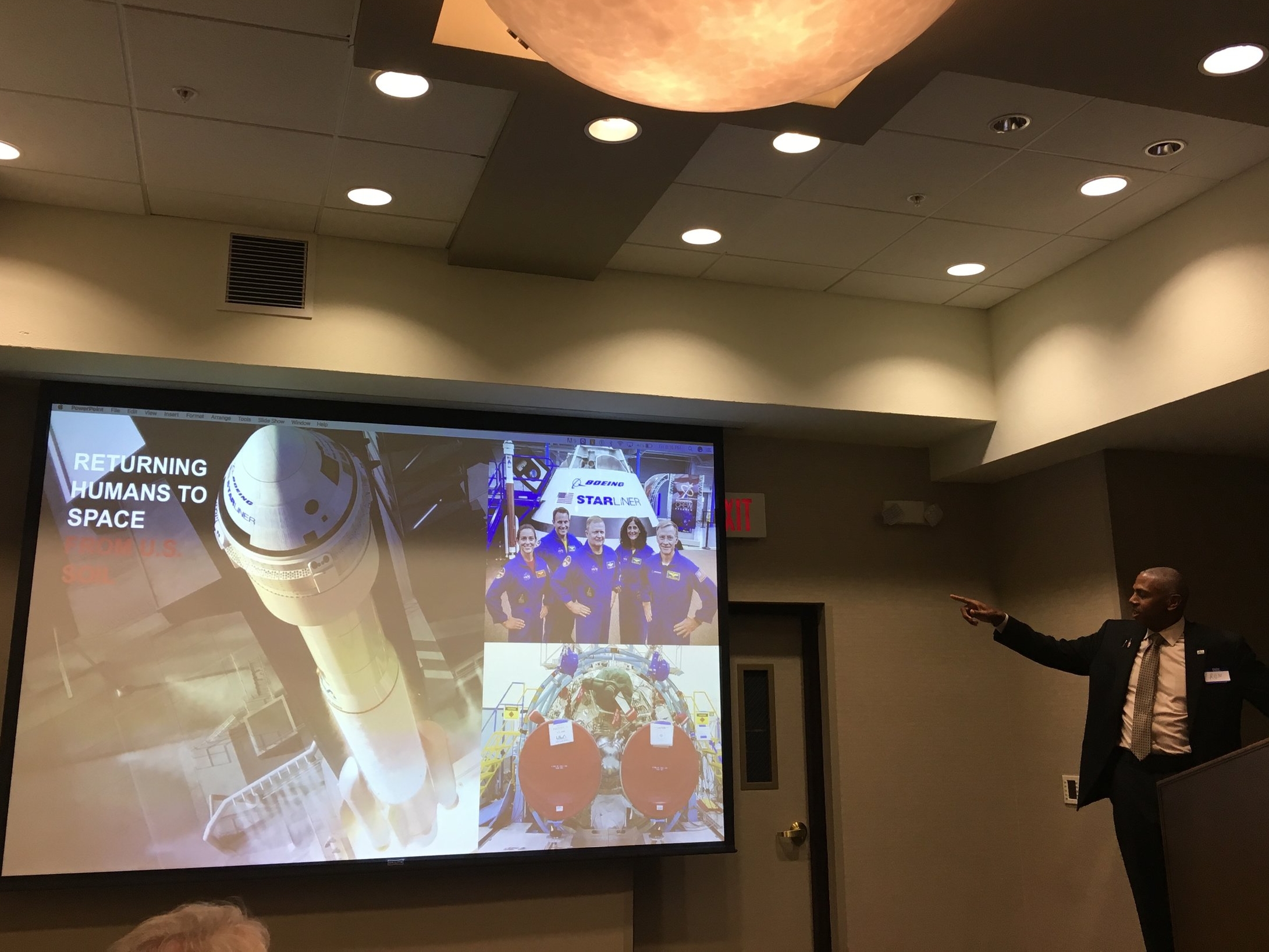Space Pioneers Banquet–Autumn 2018
On Friday 26 October, I attended the biannual banquet held by the Missile, Space, and Range Pioneers at the Courtyard Marriott Cocoa Beach. Established in 1966, Space Pioneers is a non-profit organization made up by former and current workers in aerospace, largely centered around Cape Canaveral and Kennedy Space Center. Through the grace of the organization, non-members are invited to attend the banquet as guests. This was my second Pioneers Banquet, having attended the Autumn 2017 event as well, when the special guests were Shuttle/ISS astronaut Nicole Stott and students from the Weiss School of Palm Beach. This time, the Weiss School returned to give an update on the progress of their CubeSat, and were joined as special guests by Myron “Ron” Fortson, Director of Government and Commercial Operations at United Launch Alliance.
The banquet is a special event for more reasons than just its esteemed speakers. The people who make up the Missile, Space, and Range Pioneers itself could be speakers in their own right. You never know who you’re brushing shoulders with. For instance, last year, I ended up sitting next to the former base manager for Rocketdyne/Rockwell at KSC/CCAFS, who arrived at the Cape in the early-60s. This year, the Director of Spaceport Operations at Space Florida was at our table. He told us about his work, and the upcoming test of Orion’s launch escape system at Pad 46. It turns out he had connections to my friend and fellow Space Hipster, Jean Wright. Also at the table was a gentleman who arrived here in the early-60s who worked on cleaning and safeing the launchpads. He told us about the Titan-II rocket, as well as his later work at Port Canaveral. The table next to us was largely from Boeing. It’s impossible to meet everyone, but being around the people whose hands-on work moved space exploration along is a true privilege.
Social hour underway before dinnertime.
Chelsea Partridge introduces the speakers.
As the social hour and dinnertime came to a close, the speakers took to the podium. Firstly, students from the Weiss School gave a presentation about their CubeSat, aptly named “WeissSat,” launching aboard a SpaceX Falcon 9 from Vandenberg on 19 November 2018 as part of the Spaceflight SSO-A mission. The middle school students at the school helped to devise several different experiments and observations for the CubeSat to conduct in sun-synchronous polar orbit, including gathering data on climate, capacitors, and computer chips. It is exciting to see the project develop and get a launch date a year after seeing the first presentation. Even more exciting is seeing young people have the opportunity to participate in spaceflight. It’s an achievement they will never forget. Ultimately, CubeSats are a wonderful medium for schools, universities, and other student groups and projects to interact with spaceflight. With the evermore powerful microchip becoming smaller in size each year according to Moore’s law, these tiny satellites also have growing potential for usefulness and affordability.
Weiss students present on their CubeSat.
After the Weiss School completed their presentation, Ron Fortson was introduced and took the podium. He has an impressive CV, beginning a career in the US Air Force at its academy, then working on ICBM trajectory analysis, before doing other work such as commanding the Delta-II squadron at the Cape. He eventually retired from the USAF to work privately with organizations such as ULA. Having prior experience with ULA working on EELV in Los Angeles, he climbed the ladder, ending up as Director of Government/Commercial Operations today. When it comes to the people behind spaceflight, a group which he has spent his entire career being a part of, Fortson says it is a “tight community. It’s different. It’s special. It’s unique.” Even in my small career so far, by comparison, I know exactly what he means. We are all invested in each others’ work. We all want to see spaceflight succeed as a new frontier that can enable a positive future for Earth. With that context, he switched gears and spoke about the work of ULA. The most common theme of his presentation was that ULA’s model is to make a positive difference in the world. “It’s not about us,” Fortson said, “it’s what we’re doing for everybody else.”
Ron Fortson begins his presentation…
… as banquet guests watch with enthusiasm.
Thanks to ULA’s close partnership with the US military and its contractors over the decades, ULA has helped launch satellites that help the United States monitor threats and communicate with forces abroad. For instance, ULA launched the infrared satellites that can detect rocket launches anywhere in the world at any time, as well as the network that allows instant communication between even the two most remote places on Earth. Every satellite in the GPS network, used constantly around the world by billions of people, was installed by ULA rockets. Most of the GOES weather satellite system, which transmits weather information you receive on your phone and television, including early warning of storms and natural disasters, was placed in orbit by ULA. All of these systems, and more, have both saved and improved countless lives. However, it all starts with rocket science. The satellites cannot do their job unless they make it to orbit.
At this time, ULA is at 131 successful launches in a row, arguably the most remarkable launch success rate attained by any aerospace firm. Despite that, Fortson finds wood to knock on each time that success rate is mentioned. He stipulates that “a rocket has no memory.” Though each launch appears to build upon the success of the prior ones, each rocket is still a separate project that does not intrinsically know the prior successes. It still comes down to the tenacious and dedicated team for every launch to go as planned. This does not mean, though, that their successes haven’t lead to innovations along the way. For example, one of the more frequent issues that can cause delays is upper level wind sheer. When winds in the upper atmosphere move sharply in opposite directions, they can destroy a rocket. ULA devised a system of balloons that can transmit immediate data about these winds that the rocket’s computer automatically adjusts for before T-0. They have also innovated RAN (right ascension/node) steering to allow more leeway in launch windows for flying into proper orbital parameters.
The ultimate goal ULA is working towards, as stated by Fortson, is to “launch any payload, in any orbit, at any time.” When it comes to launching “any payload,” integration comes into question. Normally, it can take months and years to develop an integrated rocket and payload. Quick integration allows ULA to put its contracted payloads into a waiting list of sorts, should a sooner launch become available. They also keep their contractors informed and up-to-speed with precisely what is happening with their launch vehicle and project. Efficiency and affordability seem to be their two largest goals as a company.
A very exciting slide!
ULA’s goals for the future include crewed spaceflight and the development of their new vehicle, Vulcan, both slated to arrive in the coming years. It was exciting to learn that the updated Centaur second stage for crewed Atlas V launches, with two engines opposed to the usual one, is here at Cape Canaveral being fitted and finalized. The crew access arm at LC-41 was recently installed and is ready to go, and astronauts are training with the vehicle and new launch escape system at the pad. The next link in the daisy-chain for crewed flight is integrating the LVA, launch vehicle adapter, which will connect the Boeing CST-100 spacecraft to the Centaur upper stage. The estimate for first tests with the crew vehicle are early 2019, with missions to the ISS coming afterwards.
Artist concept of a Vulcan Heavy rocket departing LC-41.
Then comes Vulcan. ULA’s new launch vehicle will have the versatility of both the Atlas V and Delta IV systems, being able to carry a diverse range of payload to a diverse range of destinations via different configurations. Vulcan will share pad LC-41 with the Atlas V, which is currently being fitted to support both vehicles. Part of this process involved unearthing the old missile-row era railroad tracks at the Cape. According to Fortson, Vulcan test articles and first mission hardware are currently being constructed at ULA’s assembly facility in Decatur, which I was fortunate enough to get a tour of with Space Hipsters in April 2017. Our tour guide there, an aerospace engineer working on Vulcan, told us to expect exciting things soon, and his words proved accurate! A partnership with Jeff Bezos’s Blue Origin is supplying Vulcan’s DE-4 engine. Another partnership with a Swiss firm to build the payload-fairing using autoclave compartment technology has already led to the first articles being completed at Decatur. Another innovation the Vulcan project has led to is the longest monolithic SRB (solid rocket booster, with one chamber), the GEM-63. This will present a simpler and less dangerous alternative to the multi-chambered SRBs of the past, like those of the Space Shuttle. Vulcan is predicted to arrive in 2021, with first contracted flights in 2022. New aerospace projects always seem to have optimistic estimates, though perhaps ULA will prove that standard wrong based on their great track record.
Vulcan performance table. The booster will have great versatility.
Fortson ended his presentation with a Q&A, in which the question of advice for the young people in the audience was asked. In response, Fortson said “when opportunities arise, take them; and whatever you’re doing, do the very best you can.” If you are the best at what you do, whatever it may be, there is a place for you in space exploration - advice I have heard more than once. If you achieve this, as Neil Armstrong once said in an interview, “the program will find you.”
Fortson ended his speech, and all the speakers were presented with a lifetime membership in the Missile, Space, and Range Pioneers organization. Even after the event concluded, many stayed and chatted. Luckily, I was able to meet Ron Fortson with my friends and colleagues! In that interaction came another surprise. We also met someone who was integral in developing the Shuttle’s nose cone.
L-R: Ken Kremer, Jean Wright, Chris Boyd, the Author, Ron Fortson, and Charles Kuhlman. (Photo: Ken Kremer/SpaceUpClose)
I am looking forward to the spring banquet. Hopefully the Weiss School will return to tell us the results of their CubeSat experiments, and other speakers will regale us with fascinating updates in space exploration. By then, the Atlas V could even be launching humans to space from US soil again.
ad meliora
If you are interested in becoming part of the Missile, Space, and Range Pioneers, contact:
Chelsea Partridge
chelsea.r.partridge@gmail.com
http://missileers.org
Images and Videos Courtesy of the Author, except where noted otherwise
Cover image - Pam Dirshka/Space Pioneers
BIBLIOGRAPHY
Fortson, Myron. Lecture, Space Pioneers Fall Banquet 2018, Courtyard Marriott, Cocoa Beach, FL, October 26, 2018.
MSRP-Admin. "Buy Tickets Now! Fall Banquet October 26, 2018." Missile, Space, and Range Pioneers. October 22, 2018. http://missileers.org/buy-tickets-now-fall-banquet-october-26-2018/.
The Weiss School. "The Weiss CubeSat Development Team." Lecture, Space Pioneers Fall Banquet 2018, Courtyard Marriott, Cocoa Beach, FL, October 26, 2018.











